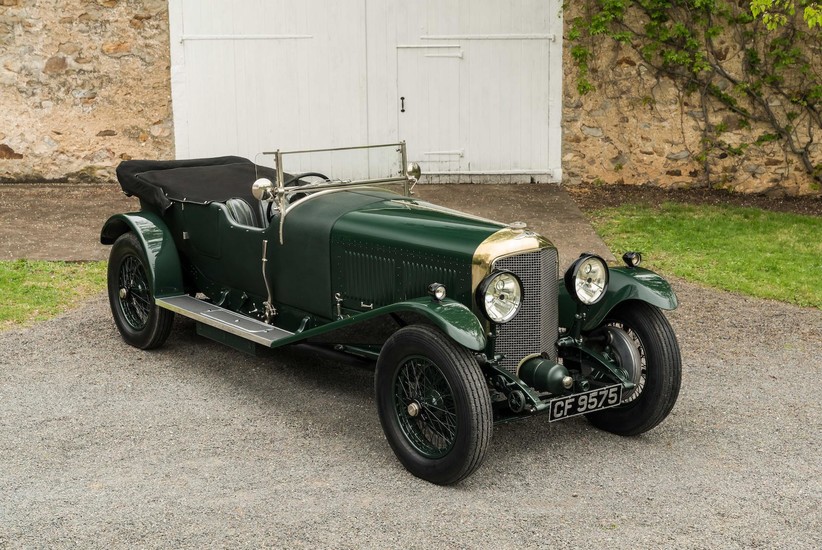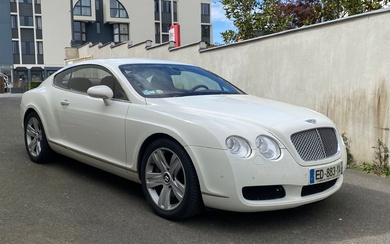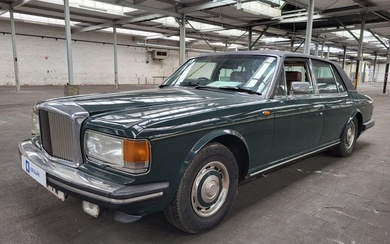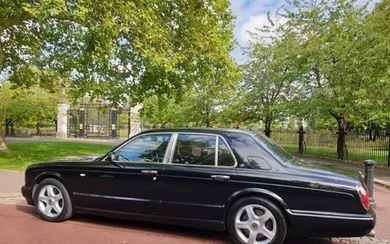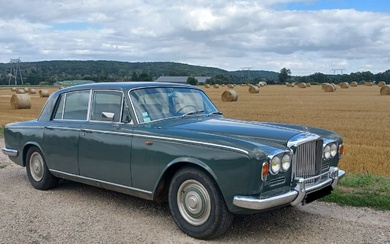1930 Bentley Speed Six Sports Tourer
1930 Bentley Speed Six Sports Tourer
Coachwork in the style of Vanden Plas
Chassis no. FR2639
Engine no. FR2641S
6,597cc SOHC Inline 6-Cylinder Engine
4 Overhead Per Cylinder
180bhp at 3,500rpm
4-Speed 'C Type' Gearbox
Front and Rear Leaf Spring Suspension
4-Wheel Drum Brakes with Servo Assist
*Matching numbers Speed Six, documented by Clare Hay Report
*Over 30 years in present ownership
*Desirable original low radiator specification with single port block
*Very original chassis on an original wheelbase
*Previously owned by Dr. Fred Simeone, and Virgil Millett
THE SPEED SIX BENTLEY
'It is extraordinarily difficult to explain in words or writing the exact fascination of a big, fast car of the type so ably represented by the big Bentley speed model.' The Autocar on the Bentley Speed Six, September 5th, 1930
Walter Owen Bentley established Bentley Motors in 1919 in the North London suburb of Cricklewood, though deliveries did not begin until 1921. The first model, a 3-liter car, was powered by a four-cylinder, single overhead camshaft engine with four valves per cylinder. It was a mechanical theme perpetuated in the greatly refined six-cylinder 6½-Liter model of 1926. The need for a larger car had resulted from Bentley's customers specifying bodies of a size not envisaged when the 3-Liter was conceived.
W.O. saw a great deal of sporting potential in the 6 1/2 model. So in late 1928 the Speed Six was announced, and the first chassis delivered in 1929. The changes to increase power and create a sports car, was the fitment of dual S.U. carburetors, and square shouldered radiator wearing a green badge.
The Speed Six was also the most successful of W.O. machines on the race circuit. Although the Blower captured the imaginations of schoolboys everywhere, the Speed Six, was the true hero. Between 1929 and 1931 the Speed Six achieved 5 first places and four second place finishes in major races.
At its race debut at the 1929 Double Twelve at Brooklands, the Works Speed Six was comfortably leading at an average of 92 mph, when it was forced to retire with a sheared dynamo drive.
At Le Mans in 1929 Barnato/Birkin's Speed Six won the Le Mans 24 Hour Race at an average speed of over 70mph, ahead of a trio of 4½-Liter Bentleys. The average speed would have been even faster, but W.O. Bentley order the cars to reduce to a fast tour after the retirement of the two supercharged Stutz, that were the only real threat. In fact speeds were reduced by so much Bentley Boy Jack Dunfee stopped and had a drink at the Hippodrome Pub.
In 1930 Barnato/Kidston. repeated the feat in the following year's Grand Prix d'Endurance at the Sarthe circuit ahead of similarly-mounted Clement/Watney. This victory in part due to the brilliant driving of Woolf Barnato, forcing Carraciola to over use the SS Mercedes clutch activated supercharger, and blowing the engine.
The 6½-Liter was produced for four years, during which time 544 chassis were completed, 182 of these to Speed Six specification. But the survival rate has not been good, and by the late 1990s only 185 of all types could be accounted for. As noted by Johnnie Green in 50 years of the Marque "The Speed Six was W.O.'s favorite among his illustrious machines, can be readily understood by anyone who has driven any distance to the accompaniment of the gentle roar and almost turbine-like never ending surge of power from beneath that long slim bonnet"
THE MOTORCAR OFFERED
This particular Speed Six was delivered in November of 1929. According to factory records the car was ordered by H.M. Bentley and Partners, a firm owned and operated by W.O. Bentley brother H.M. The series record indicates that the chassis was dispatched on May 28, 1929. H.M. Bentley had a very close ties to the London coach builder R. Harrisons and Sons, and later became one of its directors.
This chassis was dispatched to R. Harrisons and Son and fitted with an owner driver four door four light flexible saloon, constructed with their variant of Weymann fabric.
After the body was built, the car was returned to Bentley Motors for its final test and was listed as completed on the 1st of November, 1929. It does seem very odd that it took 5 months to complete the car, so it is believed that it was most likely sold before completion and updated by the works to 1930 Specification before its final test. The guarantee was issued on 5 of November 1929.
The first owner is listed as D.P. Gale of Netherburty Hall, in Suffolk. From an inspection of the service records, it seems to indicate that Mr. Gale enjoyed his Bentley a great deal. The first entry in the service record was in January of 1930, with the Bentley having covered some 2000 miles. By November the following year, it had covered over twelve thousand miles.
After 1932 this particular Bentley was looked after by the Riddelsdell Bros or by Mann Egerton through 1939. It seems that during this time the car had done fairly high mileage as the engine was decarbonized by H.M Bentley in 1933, Riddlesdell Bros in 1935, and then again by Mann Egerton in October 1936. It is also indicated that in 1936 the car had a rather major service performed by Mann Egerton. This included relining footbrakes, fitting new kingpins, and new brake camshafts. Also, the engine was torn down again in October of 1936 for a new ignition drive gear.
In July of 1937 the first change of owner is listed, and the car passed to a Mr. E. Butleer, of Suffolk. According to the service record, the ownership changed again in April of 1938 to G.S. Gales. The engine was rebuilt at this time and the car was recorded to have travelled over 95,000 miles. Like all Vintage Bentleys, the service records end in 1939, as Rolls-Royce had closed the service department.
The first appearance of the car postwar seems to be a picture from an Edinburgh area motor dealer. At this time the original body was still fitted along with blackout masks over the driving lights, which indicates that the car was likely used as staff car for government or military use during the war. The first known recorded owner of the car postwar was Mr. A.P. McNeile in 1959, followed by a Captain R.M. Terry. The car was seen and photographed in London by Nic Georgano in April of 1961. At this time the original body was still fitted, and the car appeared to be in good condition. Shortly after this, the original body was removed and a rather crude 2 door 4 seater was fitted. This practice of rebodying saloon Bentleys was very common in this period.
In this form it was advertised by Simmons of Mayfair Ltd in 1962. They also listed as being fresh from a full engine rebuild. The car then passed to a Mr. E.N. Corner. Its next owner was John S. MacKiernan, who imported the car to the US. At the time John MacKiernan owned 5 different Vintage Bentleys.
In 1966 John Mackiernan sold the car to well known collector David Van Schaick. Mr. Van Schaick retained the car for many years but did not use it much. This Speed Six would remain in his stable until 1977 when it was acquired by fellow collector Dr. Fred Simeone M.D.
According to Dr. Simeone, the car at the time was still fitted with the very crude two door tourer body that was place on the frame in 1962. Dr. Simeone decided to put the car through some sympathetic restoration. This restoration work was performed by noted Bentley restorer D.L. George, as well as in house work by Dr. Simeone. This restoration included the fitting of a new body and fenders in 1983 that was constructed by well known English coach builder Tony Robinson.
After Virgil Millett's passing the car was placed in static storage on the Millet family farm. It would remain there till earlier this year. It was at this time that the car was taken out of storage and delivered to a vintage Bentley Specialist for recommissioning.
The car was put through a compete inspection. This service included dropping the sump, front brake inspection, and gearbox inspection. When the sump was dropped it was discovered that their was coolant present in the oil. A cylinder leak down test was performed and it was determined that the block seems to have developed a crack in cylinder number 5.
The car was driven over a very short distance to test the rest of the chassis. The car seems to drive and behave very well, and behaves in a manner consistent with its sheltered existence for the last 40 years. The gearbox is very good C Type gearbox that shifts very easily. This particular Speed Six also retains many of its original fittings, including its original fuse boxes, generator cutout, front shock absorbers, headlights, and side lights.
The new owner will have the opportunity when addressing the engine issue to build the power-plant to his or her specifications. Parts are readily available and many of W.O. Bentley designs were overbuilt, allowing modern enthusiast to extract a great deal of performance. Some Speed Sixes that have been dyno'd at well over 200hp and with almost unbelievable torque figures to match.
The Speed Six has long been thought of as the most desirable car for Bentley enthusiasts. They are much less finicky then blowers and in some ways a lot more enjoyable to drive. Even though they are of an imposing size, they do handle extremely well- much better than other large cars of the 1920s and 1930s. When well set up, they are incredible long distance rally cars, able to cover vast distances at high speed in comfort. They are considered one of the ultimate prewar British motoring experiences and enable their lucky owners to feel what it must have been like to race the Blue Train, or thunder down the Mulsanne Straight.
View it on
Estimate
Time, Location
Auction House
1930 Bentley Speed Six Sports Tourer
Coachwork in the style of Vanden Plas
Chassis no. FR2639
Engine no. FR2641S
6,597cc SOHC Inline 6-Cylinder Engine
4 Overhead Per Cylinder
180bhp at 3,500rpm
4-Speed 'C Type' Gearbox
Front and Rear Leaf Spring Suspension
4-Wheel Drum Brakes with Servo Assist
*Matching numbers Speed Six, documented by Clare Hay Report
*Over 30 years in present ownership
*Desirable original low radiator specification with single port block
*Very original chassis on an original wheelbase
*Previously owned by Dr. Fred Simeone, and Virgil Millett
THE SPEED SIX BENTLEY
'It is extraordinarily difficult to explain in words or writing the exact fascination of a big, fast car of the type so ably represented by the big Bentley speed model.' The Autocar on the Bentley Speed Six, September 5th, 1930
Walter Owen Bentley established Bentley Motors in 1919 in the North London suburb of Cricklewood, though deliveries did not begin until 1921. The first model, a 3-liter car, was powered by a four-cylinder, single overhead camshaft engine with four valves per cylinder. It was a mechanical theme perpetuated in the greatly refined six-cylinder 6½-Liter model of 1926. The need for a larger car had resulted from Bentley's customers specifying bodies of a size not envisaged when the 3-Liter was conceived.
W.O. saw a great deal of sporting potential in the 6 1/2 model. So in late 1928 the Speed Six was announced, and the first chassis delivered in 1929. The changes to increase power and create a sports car, was the fitment of dual S.U. carburetors, and square shouldered radiator wearing a green badge.
The Speed Six was also the most successful of W.O. machines on the race circuit. Although the Blower captured the imaginations of schoolboys everywhere, the Speed Six, was the true hero. Between 1929 and 1931 the Speed Six achieved 5 first places and four second place finishes in major races.
At its race debut at the 1929 Double Twelve at Brooklands, the Works Speed Six was comfortably leading at an average of 92 mph, when it was forced to retire with a sheared dynamo drive.
At Le Mans in 1929 Barnato/Birkin's Speed Six won the Le Mans 24 Hour Race at an average speed of over 70mph, ahead of a trio of 4½-Liter Bentleys. The average speed would have been even faster, but W.O. Bentley order the cars to reduce to a fast tour after the retirement of the two supercharged Stutz, that were the only real threat. In fact speeds were reduced by so much Bentley Boy Jack Dunfee stopped and had a drink at the Hippodrome Pub.
In 1930 Barnato/Kidston. repeated the feat in the following year's Grand Prix d'Endurance at the Sarthe circuit ahead of similarly-mounted Clement/Watney. This victory in part due to the brilliant driving of Woolf Barnato, forcing Carraciola to over use the SS Mercedes clutch activated supercharger, and blowing the engine.
The 6½-Liter was produced for four years, during which time 544 chassis were completed, 182 of these to Speed Six specification. But the survival rate has not been good, and by the late 1990s only 185 of all types could be accounted for. As noted by Johnnie Green in 50 years of the Marque "The Speed Six was W.O.'s favorite among his illustrious machines, can be readily understood by anyone who has driven any distance to the accompaniment of the gentle roar and almost turbine-like never ending surge of power from beneath that long slim bonnet"
THE MOTORCAR OFFERED
This particular Speed Six was delivered in November of 1929. According to factory records the car was ordered by H.M. Bentley and Partners, a firm owned and operated by W.O. Bentley brother H.M. The series record indicates that the chassis was dispatched on May 28, 1929. H.M. Bentley had a very close ties to the London coach builder R. Harrisons and Sons, and later became one of its directors.
This chassis was dispatched to R. Harrisons and Son and fitted with an owner driver four door four light flexible saloon, constructed with their variant of Weymann fabric.
After the body was built, the car was returned to Bentley Motors for its final test and was listed as completed on the 1st of November, 1929. It does seem very odd that it took 5 months to complete the car, so it is believed that it was most likely sold before completion and updated by the works to 1930 Specification before its final test. The guarantee was issued on 5 of November 1929.
The first owner is listed as D.P. Gale of Netherburty Hall, in Suffolk. From an inspection of the service records, it seems to indicate that Mr. Gale enjoyed his Bentley a great deal. The first entry in the service record was in January of 1930, with the Bentley having covered some 2000 miles. By November the following year, it had covered over twelve thousand miles.
After 1932 this particular Bentley was looked after by the Riddelsdell Bros or by Mann Egerton through 1939. It seems that during this time the car had done fairly high mileage as the engine was decarbonized by H.M Bentley in 1933, Riddlesdell Bros in 1935, and then again by Mann Egerton in October 1936. It is also indicated that in 1936 the car had a rather major service performed by Mann Egerton. This included relining footbrakes, fitting new kingpins, and new brake camshafts. Also, the engine was torn down again in October of 1936 for a new ignition drive gear.
In July of 1937 the first change of owner is listed, and the car passed to a Mr. E. Butleer, of Suffolk. According to the service record, the ownership changed again in April of 1938 to G.S. Gales. The engine was rebuilt at this time and the car was recorded to have travelled over 95,000 miles. Like all Vintage Bentleys, the service records end in 1939, as Rolls-Royce had closed the service department.
The first appearance of the car postwar seems to be a picture from an Edinburgh area motor dealer. At this time the original body was still fitted along with blackout masks over the driving lights, which indicates that the car was likely used as staff car for government or military use during the war. The first known recorded owner of the car postwar was Mr. A.P. McNeile in 1959, followed by a Captain R.M. Terry. The car was seen and photographed in London by Nic Georgano in April of 1961. At this time the original body was still fitted, and the car appeared to be in good condition. Shortly after this, the original body was removed and a rather crude 2 door 4 seater was fitted. This practice of rebodying saloon Bentleys was very common in this period.
In this form it was advertised by Simmons of Mayfair Ltd in 1962. They also listed as being fresh from a full engine rebuild. The car then passed to a Mr. E.N. Corner. Its next owner was John S. MacKiernan, who imported the car to the US. At the time John MacKiernan owned 5 different Vintage Bentleys.
In 1966 John Mackiernan sold the car to well known collector David Van Schaick. Mr. Van Schaick retained the car for many years but did not use it much. This Speed Six would remain in his stable until 1977 when it was acquired by fellow collector Dr. Fred Simeone M.D.
According to Dr. Simeone, the car at the time was still fitted with the very crude two door tourer body that was place on the frame in 1962. Dr. Simeone decided to put the car through some sympathetic restoration. This restoration work was performed by noted Bentley restorer D.L. George, as well as in house work by Dr. Simeone. This restoration included the fitting of a new body and fenders in 1983 that was constructed by well known English coach builder Tony Robinson.
After Virgil Millett's passing the car was placed in static storage on the Millet family farm. It would remain there till earlier this year. It was at this time that the car was taken out of storage and delivered to a vintage Bentley Specialist for recommissioning.
The car was put through a compete inspection. This service included dropping the sump, front brake inspection, and gearbox inspection. When the sump was dropped it was discovered that their was coolant present in the oil. A cylinder leak down test was performed and it was determined that the block seems to have developed a crack in cylinder number 5.
The car was driven over a very short distance to test the rest of the chassis. The car seems to drive and behave very well, and behaves in a manner consistent with its sheltered existence for the last 40 years. The gearbox is very good C Type gearbox that shifts very easily. This particular Speed Six also retains many of its original fittings, including its original fuse boxes, generator cutout, front shock absorbers, headlights, and side lights.
The new owner will have the opportunity when addressing the engine issue to build the power-plant to his or her specifications. Parts are readily available and many of W.O. Bentley designs were overbuilt, allowing modern enthusiast to extract a great deal of performance. Some Speed Sixes that have been dyno'd at well over 200hp and with almost unbelievable torque figures to match.
The Speed Six has long been thought of as the most desirable car for Bentley enthusiasts. They are much less finicky then blowers and in some ways a lot more enjoyable to drive. Even though they are of an imposing size, they do handle extremely well- much better than other large cars of the 1920s and 1930s. When well set up, they are incredible long distance rally cars, able to cover vast distances at high speed in comfort. They are considered one of the ultimate prewar British motoring experiences and enable their lucky owners to feel what it must have been like to race the Blue Train, or thunder down the Mulsanne Straight.
